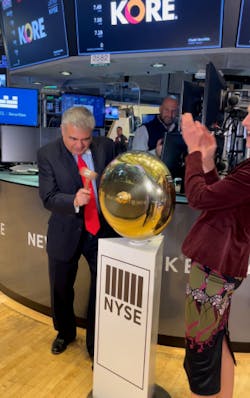Romil Bahl ringing the “first-trade” bell at the New York Stock Exchange. [Photo: KORE]
Atlanta-based wireless-technology company KORE claims that it exists at “the intersection of 5G, edge computing and IoT.” That’s a good place to be, particularly as they went public last week.
Here we chat with KORE CEO Romil Bahl about what’s going on at that busy intersection, using smart approaches to develop COVID vaccines and road bandits. Yep…road bandits. Take a look:
Smart Industry: What is "the intersection of 5G, edge computing and IoT"? What are critical capabilities with the interplay among those technologies?
Romil: The intersection of 5G, edge computing and IoT is the coming together of critical technologies that will enable the Connected Planet…the infrastructure that will enable the cutting-edge use cases we are reading about in terms of the Intelligent Planet enabled by ubiquitous connectivity.
5G, with its super high bandwidth, low latency and other IoT-friendly features such as network slicing, along with edge computing, which enables quicker decisions at the edge device or edge cloud, will create a new wave of IoT and increase effectiveness and efficiency of transporting data and enabling high-value analytics.
What you end up with is better intelligence that is needed to make better decisions, delivered in real-time. This is what enables autonomous-vehicle operations and robotics in manufacturing and healthcare or machine learning and artificial intelligence.
For these incredibly smart technologies that operate with little to no intervention, you need incredibly powerful networks and processing technologies: 5G and edge computing, respectively. But it also takes a massive volume of quality data to run these applications, and that’s where IoT is critical. IoT provides the infrastructure for millions of sensors to harmoniously communicate.
Smart Industry: Describe the role of 5G / your involvement with remote trials of COVID vaccines. Is this a good use case for future applications of 5G to solve global problems?
Romil: That is an excellent use case to describe what we call “IoT for Good.” When it comes to 5G, a lot of use cases surrounding this new generation of cellular connectivity are related to consumer use. But some of these applications are going to truly revolutionize the way we live. For connected health, accessible medicine and treatment has already started to see a sharp uptick.
We have many segments within connected health that will allow for patient advocacy and recovery outside of clinical or hospital settings, which is not only a boon to patients, but also eases the strain on healthcare systems. And in light of the pandemic, the opportunity to free resources for those who are critically ill and need on-premises treatment is one worth pursuing. Clinical trials are moving to a fully remote or decentralized model, which is helping bring medications and treatments to the public faster.
It’s not just healthcare, and it’s not just 5G technologies creating these solutions. Whether it is 5G, 4G, short range, or another connected technology, it’s all going to converge to create a truly connected planet in the next decade.
Smart Industry: How is your technology protecting drivers from road bandits?
Romil: This excellent use case of one of our customer’s drivers being saved through KORE-enabled technology is another great example of IoT for Good. This technology was developed off the back of a fleet-management solution. Managing a fleet requires managing a massive amount of moving parts. Drivers, vehicles, federal and state laws, taxes, regulations, etc. Then you add in managing maintenance and rising insurance and gas costs, while meeting customer demand. It’s a marriage of efficiency, compliance and safety. Fleet management has had to digitize to mitigate these issues, and that’s when fleet telematics really took hold. Building off that, video telemetry has allowed cameras on the road and within the vehicle cabin, but that still left a lot of manual monitoring to the fleet manager.
So now, finally, we have video monitoring backed by artificial intelligence that can detect unsafe driver behavior and immediately flag the attention of the fleet manager. In this instance, the driver was forced off the road by the kidnappers, which triggered the unsafe-lane-departure alert to the fleet manager, who was able to pull up video to identify the kidnappers and return the driver safely within a few hours.
Smart Industry: What does going public mean in the larger picture of emerging technologies?
Romil: The entire mission of KORE is to make IoT more accessible to organizations. We have had success in our nearly two decades of being in the industry, but the path to IoT for early adopters has been challenging. We have now launched an “IoT in a Box,” or one-stop shop set of services across IoT connectivity, solutions and analytics, which make it much easier for companies to adopt IoT.
This transformation, paired with KORE going public and having more visibility, will help with the IoT revolution. People might not talk about it the way we do—when referencing smart home, smart building, smart utilities, smart agriculture, fleet management and connected vehicles, or connected health applications—but it’s all IoT and in our scope of services. These technologies and solutions are going to have a large impact in consumer and industry sectors, and we anticipate being a driving force in enabling those applications.




